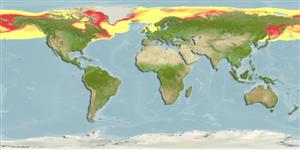|
Cetartiodactyla |
Balaenidae
Environment: milieu / climate zone / depth range / distribution range
экология
пелагический. Polar; 90°N - 0°S, 180°W - 180°E
Pacific Ocean, Northern Atlantic and the Arctic. [Bering-Chukchi-Beaufort Sea population: LR/cd; Okhotsk Sea population: EN, D; Svalbard-Barents Sea (Spitsbergen) population: CR, D: IUCN 2010 (Ref. 84930)].
Length at first maturity / Size / Вес / Возраст
Maturity: Lm 1,400.0, range 125 - 140 cm Max length : 1,800 cm TL самец/пол неопределен; (Ref. 1394); 2000 cm TL (female); наибольший вес (опубликованные данные): 100.0 t (Ref. 1394)
Lives among the pack ice, migrating to the high arctic summer, but retreating southward in winter with the advancing ice edge. Feeds on small to medium-sized invertebrates, especially krill and copepods. Bowhead whales were heavily hunted for several centuries. Today they are partially protected by the IWC. The current world population is still threatened by small-scale hunting by Alaskan, Canadian, and Russian natives. In addition, there are various forms of habitat degradation, including disturbance from oil and gas exploration and development activities (Ref. 1394). Lives among the pack ice, migrating to the high arctic summer, but retreating southward in winter with the advancing ice edge. Feeds on small to medium-sized invertebrates, especially krill and copepods (Ref. 1394).
Females calve once every 3 to 5 years, i.e., very low reproductive capacity (Ref. 118436).
Основная ссылка
ссылки | координатор | соавторы
Jefferson, T.A., S. Leatherwood and M.A. Webber. 1993. (Ref. 1394)
Статус Красного Списка МСОП (Ref. 130435)
Статус СИТЕС (Ref. 108899)
Угроза для людей
Использование человеком
рыболовство: коммерческий
FAO - рыболовство: landings, Видовой профиль | FishSource | Sea Around Us
инструменты
дополнительная информация
ресурсы в Интернет
Estimates based on models
Preferred temperature
(Ref.
115969): -1.7 - 1.5, mean -0.9 (based on 4244 cells).
устойчивость к внешним воздействиям
очень низкий, минимальное время удвоения популяции более 14 лет (K=0.03; tm=20).
Уязвимость
Very high vulnerability (88 of 100).
Категория цены
Unknown.
